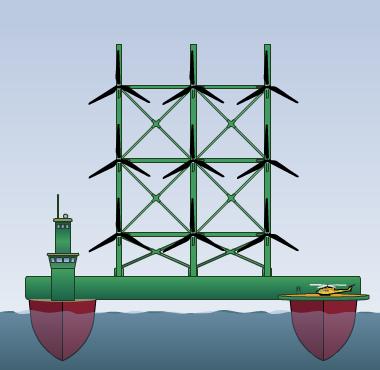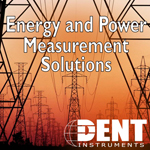Archive for the 'Wind' Category
Magenn’s floating turbine
Yesterday we looked at a mobile, maritime based wind turbine in Wind Hunter. Today, we’ll take a look at an airship based, floating turbine system from Magenn. In both cases, this is a practice of taking the turbine to richer wind resources than are available with traditional, fixed terrestrial systems.
Here’s the Magenn system in action:

Effectively, the system consists of a cylindrical helium airship where the cylinder rotates in the wind. The ends of the cylinder are coupled to generators. The entire system is tethered between 100 – 330m (300-1000 feet) above ground level to a winch system that can raise and lower the turbine to access the best wind resource or pull the turbine to earth during extreme weather. In addition to helium, the craft is also designed to make use of the magnus effect – spinning spheres create lift as is seen with golf and base balls.
In terms of efficiency, the traditional wind formula of (power = 0.5 x air density x swept area x velocity-cubed) is multiplied by 0.5 (50%) to get the efficiency of these turbines to account for the difference in swept area of a blade system vs. the cylinder. This reduced efficiency is offset by increased capacity factor due to better wind resource at higher altitudes. One other interesting aspect of these turbines is that they begin function with wind speeds of 2m/sec (4.5mph) and operate through speeds of 28m/sec (60+mph) which also increases the capacity factor of the device.
There is a 4kw system in existence and the company aims to release 10kw systems in 2008 at a target price range of $30,000 to $50,000 per unit. The 10kw system will also require around $3,500 in helium (not included) and will need to be properly permitted with local and federal aviation authorities. Lest one think this is not feasible, the US government has (and does) operate surveillance platforms consisting of tethered helim airships at heights over 5km (15,000 feet.)
Who knows, perhaps we’ll see these systems tethered and producing sometime in the near future.
Windhunter
Yesterday we ran across an interesting concept, WindHunter. Effectively, this is a mobile platform with nine large wind turbines dedicated to the manufacture of hydrogen. See an image of the concept below:

The idea is to refit old single hull oil tankers (now illegal for oil transport) to support a large platform on which will be placed large (5MW) wind turbines. The power generated will be used to electrolyze water separating it into hydrogen and oxygen (the plan calls for selling the hydrogen, but oxygen is valuable too.)
While this is a large and unproven project, the potential is apparent. Since the platform is mobile, it can travel to wind rich enviroments and orient itself to optimally harvest the wind resource. It can use the water as raw material for hydrogen production as well as for cooling. The hydrogen gas sales are projected to be near $25M per year at just 25% capacity factor for the platform. Modern land-based turbines are seeing capacity factors closer to 35% and with the mobility factor, it may be possible to boost the capacity factor of the WindHunter turbines beyond that threshold.
There are certain to be technical obstacles to overcome (engineering, storm worthiness, hydrogen transport, etc) but it’s certainly a concept that should get more examination and perhaps will come into being. 1 comment
The Forgotten Renewable
Renewable technologies are not all created equal, solar and wind are hot. These two technologies grab the headlines and are attracting R&D and implementation dollars in large hunks (solar more of the R&D and wind more of the implementation.) There is nothing wrong with that, both wind and solar have great benefits and anything that increases the footprint of renewable electricity generation is a good thing.
If we look at wind and solar respectively, we’ll notice that they each have strengths and weaknesses (as do all renewable generation technologies) that make it curious, in some respects, that these are the technologies that have caught fire.
Wind for instance, is relatively easy and cheap to develop (it’s pretty easy to see where it’s windy and a site assessment is cheap and quick to perform) on the advantage side. Modern turbines can provide capacity factors approaching 40% if sited well and provide large nameplate capacity of greater than 1MW per turbine. In addition, wind is modular. You don’t have to build a whole project at one time, several phases can be used to schedule the development which spreads cost and risk over time which is attractive to developers.
On the downside of developing wind projects, one doesn’t really know when the wind will blow, how fast, or how long. Yes, good site assessments mitigate this risk to some degree, but one is never quite sure of the wind. Consequently, the power purchase agreements for wind projects don’t bring in as much revenue as baseload technologies, right now, developers are lucky to get $45/MWh on their PPAs. Also, developers buy and install based on nameplate capacity which is now about $1.5M per nameplate MW. But, even with 40% capacity factor and 99% availability factor, at any given time the developer is harvesting only 400KWh per installed MW. Without the production tax credit, it would be difficult to make the numbers work for wind developers.
Solar (PV – not necessarily CSP) brings similar benefits and liabilities to the table as wind. Solar technology readily lends itself to small, distributed installations, something few other technologies bring to the table. As with wind, it’s pretty easy to develop as areas that receive good direct sunlight are obvious and site assessments are cheap and fast. The current generation of solar cells have efficiency levels approaching 20% and have a lifetime of 20 years. Unlike wind, solar remains very expensive to develop coming in around $8M per MW. The expected capacity factor for a solar project is in the 25% range. The cost of maintenance of a solar system is very low however, there are few moving parts and once installed, these systems are very reliable. Also, solar production tends to peak during the times that demand for electricity are at their highest, so the capacity factor and production to demand match is much better than wind.
The obvious disadvantages to solar are cost to develop and capacity factor. There is no way around it, solar is expensive to acquire and install relative to other technologies. The capacity factor of around 25% is also a limitation without sufficient power storage capabilities, which increase the cost of these systems even more. A hidden aspect of solar that isn’t well publisized is that the power produced is direct current and needs to pass through an inverter to enable standard AC power consumption from the grid, which causes even more power loss and cost.
That’s not to say that solar or wind are bad, they each bring benefits to the table, but in spite of their obvious benefits, their liabilities nearly preclude them from displacing say, a 200MW coal generation plant because consumers, really do expect the lights to come on when the light switch is flipped. That brings us to the key point of this entry: geothermal generation is a renewable technology that has the potential to displace coal plants unlike wind or solar, but is largely ignored in the renewable energy discussion.
Geothermal has its advantages and disadvantages like any other renewable technology. On the plus side, it’s baseload generation producing 90% capacity factor with 97% availability day-in and day-out. It uses traditional turbine generation technology that would be familiar to anyone with steam turbine experience (many fossil plants heat water to produce steam to generate electricity.) In closed system implementations, it is zero emission generation (and in open systems, near zero emission.) Geothermal costs on average around $3M per MW to develop, more expensive than wind, but far less so than solar. But better capacity and predictability than either.
On the negative side, it’s harder to know where to build such a plant. Unless there is a geyser or volcano, it’s not apparent to the lay person where geothermal resource might reside. Site assessment is expensive and takes a long time to complete relative to wind or solar projects due to drilling requirements. Even when a promising site is identified, there is no guarantee that it can produce at utility scale without drilling test holes and flow testing the resource.
Given the relative strengths and weaknesses of the harvest technology, it’s not clear why geothermal is largely ignored except that perhaps the resource it harvests is less accessible to the public. Anyone understands sunshine and wind, heat transfer from magma to rocks to water is a little more esoteric. But one has to wonder, given the benefits that geothermal harvest bring to the table if we should be diverting more of the attention, R&D, and implementation dollars to geothermal projects? As it stands, geothermal is the forgotten renewable.
Wind turbines not a threat to Bird Population
From Renewable Energy Access:
Comments are off for this postProponents of wind energy in the U.S. have long argued that the overall impact of properly sited wind turbines on birds is extremely low compared with other human-related activities and structures. Now a congressionally mandated study released by the National Research Council (NRC) on Thursday offers new findings to support this argument — and is recommending that implementing national-level policies to enhance the benefits of wind energy and minimize its harms would help guide state and local regulatory efforts.
Tradeoff: Wind Power vs. Avian Well-being
Over the weekend, another article cautioning on the evils of wind power, bird kills, made it into wide circulation. This is not a new issue and it’s not an issue easily solved as it pits two natural groups of allies against one another over a single issue. Generally speaking, people promoting the growth and use of renewable electricity generation are doing so not only out of the desire for profit but also to lessen the impact of electricity generation on the environment as a whole. And generally speaking, people working to protect the bird populations are doing so out of a sense that it is our responsibility to protect the environment and particularly those residents of the environment who don’t have a voice in the process, like plants and animals.
The key to recognize is that both groups have the same goal in common, these groups are not natural enemies. But, through the years wind operators and bird conservation groups seem to have lost sight of their basic shared mission.
Let’s be honest with ourselves over this particular tradeoff (avian death vs. wind turbines.) First, we need to acknowledge that the hunger for electric power is not going to slacken, it increases each year. Over the past 14 years according to Electric Power Monthly data, demand has increased over 30%. The demand for electric power has grown faster than renewable electricity generation can be installed and operated, so over that same period, while the gross amount of renewable power is much larger, the relative percentage share of renewable power is about the same and in some areas a little less. What does the heavy lifting for the grid? In order, coal (~50%), nuclear (~20%), natural gas (~17%), hydroelectric (~6%), and everything else (~7%.)
Since coal is the largest portion of the generation portfolio, let’s look at the impact of generating a megawatt hour. Emissions of around 1,000kg of carbon dioxide and around 15kg of sulphlur oxides, nitrogen oxides, and other trace contaminents like mercury. A megawatt of wind power by contrast is zero emission (yes, there were emissions accrued during manufacturing, transport, and construction but there no different than the coal plant had – so let’s not cloud the issue with that extraneous information.)
So in the end, we’re talking about trading off the negative environmental impacts of non-renewable generation vs. the health and well being of birds. The negative environmental impacts of non-renewable power generation affects all species on the planet. The turbines affect birds, not all birds, some birds. Not wholesale killing, an occasional bird death. When viewed through this lens, the answer should be obvious. Build as much renewable generation as we can because that will help the overall ecosystem and benefit all species, including birds. However, we should take measures to minimize the avian impact where possible. Ultimately, there needs to be a partnership between the avian conservation groups and the wind operators where cooperation is routine to serve a joint goal: minimize avian impact while promoting and growing renewable energy. No one relishes the thought of a Golden Eagle death at the hands of a wind turbine.
One item that has always been a curiosity for me on this issue is the singling out of wind turbines. Cellular telephone network towers, radio towers, buildings, and cars all kill these birds in large numbers too. I don’t see any campaigns to attack these structures; it only seems to be wind turbines that attract attention. It’s clear, cooperation, not conflict between the groups is necessary. Who knows, perhaps what is learned in minimizing avian impact for turbines could be used on other structures?
A final word on this, minimizing avian impact does not mean zero avian impact. The societal and environmental benefit of renewable power is worth making tradeoffs and clearly, this is one of them.









